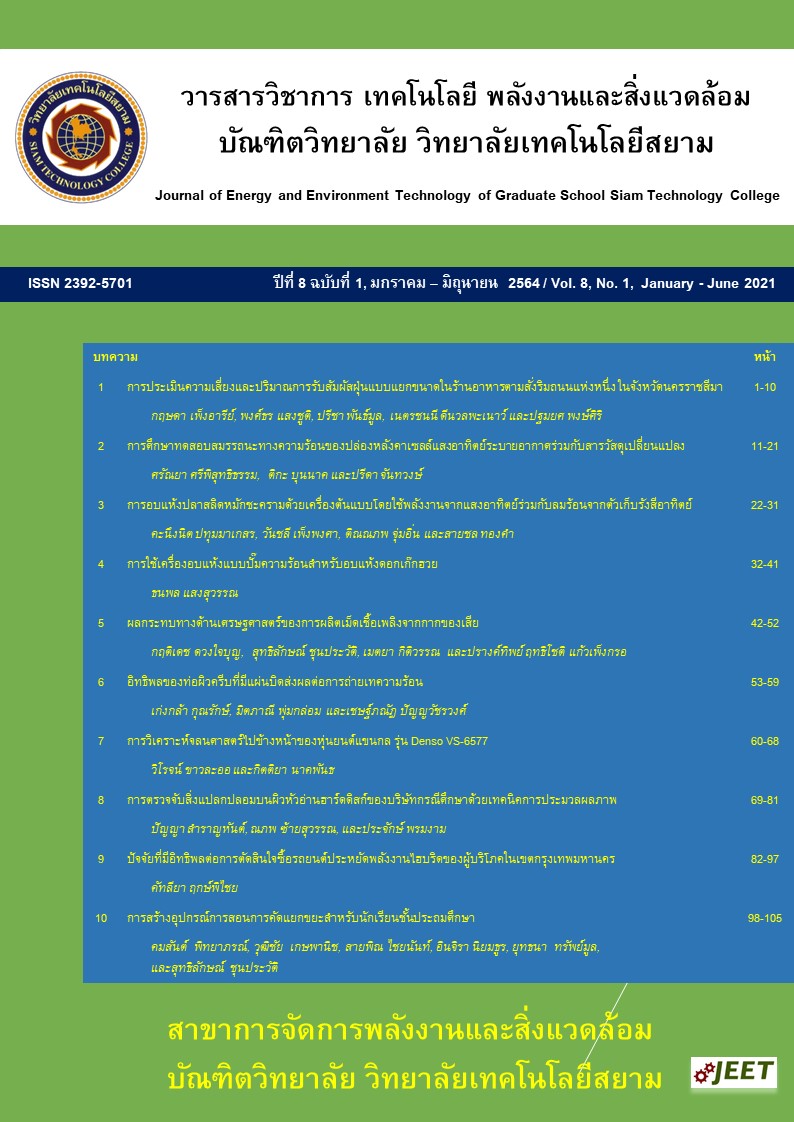BUILDING A WASTE SORTING TEACHING DEVICE WITH RFID TECHNOLOGY FOR ELEMENTARY SCHOOL STUDENTS
Main Article Content
Abstract
The research aims to create waste sorting teaching equipment for primary school students. Students will be able to separate four types of waste: general waste, organic waste, hazardous waste and recycle. Teaching equipment consists of 4 small plastic tanks, made into simulated trash cans. Each tank is equipped with a Radio Frequency Identification Scanner (RFID Scanner) for each type of waste and a monitoring microcontroller Arduino UNO R3 and there will be 20 garbage image cards, of which 5 cards for each type of waste. On the card, install the RFID of the type of waste. In the training, when each garbage card touches the tank's RFID scanner, it scans the signal to the controller, which checks if it is correct. If right, it will sound "right type" and the lid will open. If it is wrong, it will sound "wrong type" and the lid will not open. When the teaching equipment was tested on 6 primary school teachers and 12 students in Grade 1-6, the evaluation results (based on a full score of 5) showed that the research was practical, with an average score of 4.8, and overall satisfaction with score at 4.4. For knowledge gain, it was mentioned by the users that the teaching equipment had a clear purpose with average score of 4.8, and can be a good tool for educational use with the average score at 4.6.
Article Details

This work is licensed under a Creative Commons Attribution-NonCommercial-NoDerivatives 4.0 International License.
เนื้อหาและข่อมูลในบทความที่ลงตีพิมพ์ในวารสารวิชาการ เทคโนโลยี พลังงาน และสิ่งแวดล้อม บัณฑิตวิทยาลัย วิทยาลัยเทคโนโลยีสยาม ถือเป็นข้อคิดเห็นและความรับผิดชอบของผู้เขียนบทความโดยตรง ซึ่งกองบรรณาธิการวารสารไม่จำเป็นต้องเห็นด้วย หรือว่าร่วมรับผิดชอบใด ๆ
บทความ ข้อมูล เนื้อหา รูปภาพ ฯลฯ ที่ได้รับการตีพิมพ์ในวารสารวิชาการ เทคโนโลยี พลังงาน และสิ่งแวดล้อม บัณฑิตวิทยาลัย วิทยาลัยเทคโนโลยีสยาม ถือเป็นลิขสิทธิ์ของวารสารวิชาการ เทคโนโลยี พลังงาน และสิ่งแวดล้อม บัณฑิตวิทยาลัย วิทยาลัยเทคโนโลยีสยาม หากบุคคล หรือหน่วยงานใดต้องการนำทั้งหมด หรือส่วนหนึ่งส่วนใดไปเผยแพร่ต่อ หรือเพื่อกระทำการใด ๆ จะต้องได้รับอนุญาต เป็นลายลักษณ์อักษรจากวารสารวิชาการ เทคโนโลยี พลังงาน และสิ่งแวดล้อม บัณฑิตวิทยาลัย วิทยาลัยเทคโนโลยีสยาม เท่านั้น
References
ปันทา, น. (2554 ). ถังขยะพูดได้ . วิทยาลัยเทคโนโลยีพายัพและบริหารธุรกิจ.
ผาลาวรรณ, ส. ( 2558). การประยุกต์ใช้เทคโนโลยี RFID ในงานห้องสมุด. In ส. ผาลาวรรณ, วารสารวิจัย สมาคมห้องสมุดแห่งประเทศไทยฯ (p. 1).
เรืองประทีป, น. (2561). การศึกษาการจัดการคลังสินค้าโดยใช้เทคโนโลยี RFID . วิทยาลัยเทคโนโลยีอรรถวิทย์พณิชการ.
สงวนวัฒนา, บ. (2558). ระบบตรวจนับครุภัณฑ์ด้วย RFID . Thailand: มหาวิทยาลัยวิทยาลัยราชภัฎกำแพงเพชร.
สุวรรณเพชร, ป. (2560). เรียนรู้และลองเล่น Arduino เบื้องต้น .วิทยาลัยเทคนิคชัยภูมิ
ทีมข่าวเฉพาะกิจไทยรัฐออนไลน์. (12 06 2019). วิกฤติ "ขยะตกค้าง" ปีเดียวเท่า 3 ราชมังฯ เฉลี่ยต่อวันทิ้งคนละ 1 กก. เข้าถึงได้จาก https://www.thairath.co.th/: https://www.thairath.co.th/scoop/1589606
HOW TO USE ISD1820 VOICE RECORDER AND PLAYER (ออนไลน์) เข้าถึงได้จาก : https://www.instructables.com/id/HOW-TO-USE-ISD1820-VOICERECORDER-AND-PLAYER/
สอนใช้งาน Arduino เริ่มต้นติดตั้งโปรแกรม Arduino IDE (ออนไลน์) เข้าถึงได้จาก : https://www.myarduino.net/article/74/
การใช้งานโมดูลอ่าน RFID กับ Arduino แบบง่ายๆ (ออนไลน์) เข้าถึงได้จาก : https://www.ioxhop.com/b/37
มหาวิทยาลัยแม่โจ้. (2555). 5R ลดปริมาณขยะ ลดโลกร้อน. Retrieved from coordinate.mju.ac.th: https://coordinate.mju.ac.th/wtms_webpageDetail.aspx?wID=143
สมสุภาพรุ่งยศ, น. (2560). การประยุกต์ใช้เทคโนโลยีอาร์เอฟไอดีสำหรับการคัดแยกนักศึกษาที่มาใช้บริการ. กรุงเทพมหานคร: มหาวิทยาลัยเทคโนโลยีราชมงคลสุวรรณภูมิ.
วัชรากร หนูทอง, อ. น. (2547). RFID เทคโนโลยีสารพัดประโยชน์. In สาร NECTEC (p. 15). กรุงเทพ: NECTEC.


